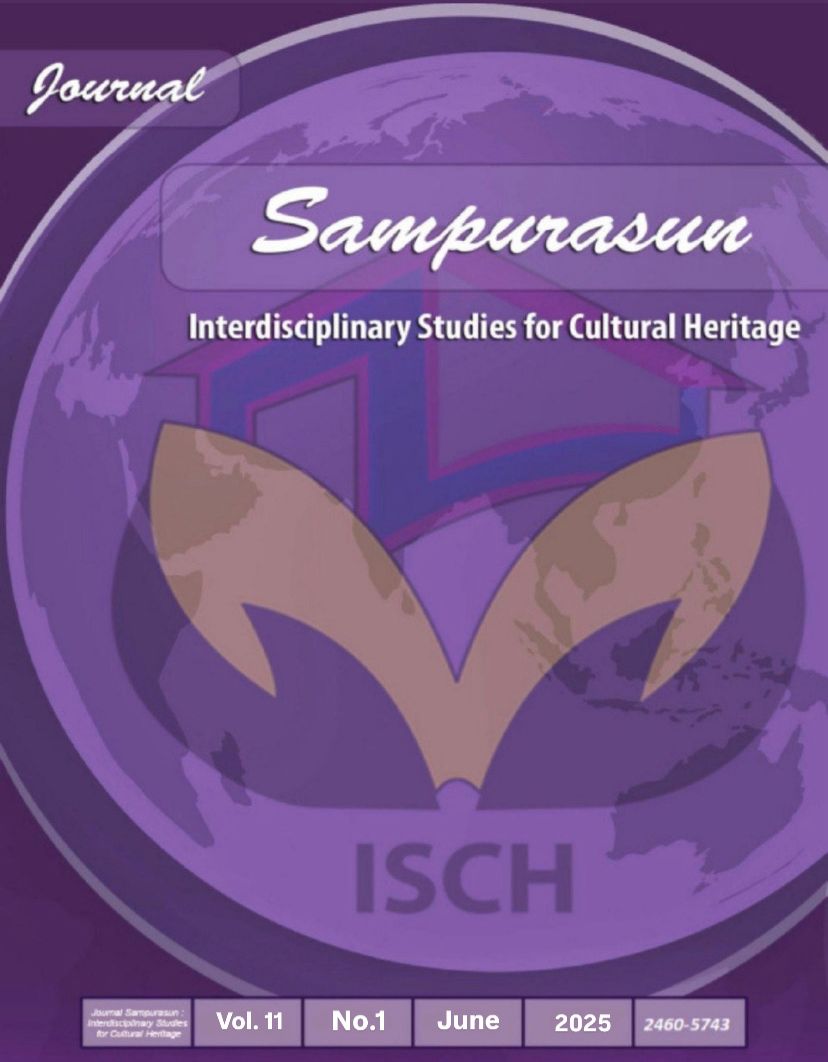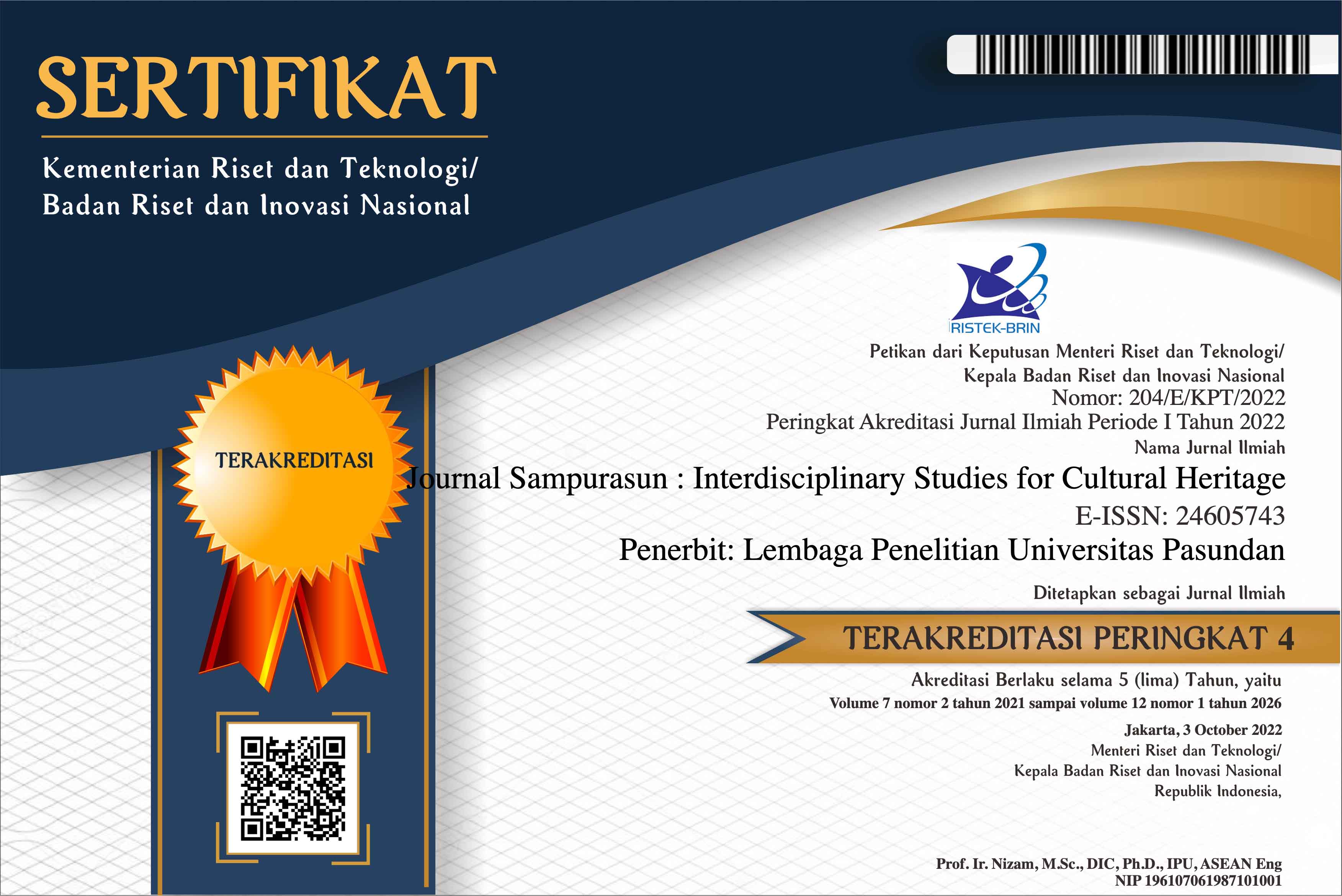VARIATIONS OF SYNONYMS IN THE CULTURAL CONTEXT OF THE SCRIPTURE OF THE HARRY POTTER SERIES FILM BY J.K. ROWLING: A SEMANTIC STUDY
DOI:
https://doi.org/10.23969/sampurasun.v11i1.22756Keywords:
Keywords: semantics, types of synonym, cultural contextAbstract
This article purposed to: (1) identify and analyze types of synonyms based on Palmer's theory (Alexander, 2018) and (2) examine the meaning relationships contained in each type of synonym by referring to Leech's theory (Feist, 2022). This research employs a qualitative descriptive method through several stages, including watching films and reading dialogue scripts from the Harry Potter series, grouping data according to types of synonyms, analyzing data based on identified problems, and drawing conclusions from the results of the analysis. The findings reveal five types of synonyms with the following distribution: 37.2% overlapping synonyms, 25.7% stylistic synonyms, 25.7% synonyms with emotive or evaluative meaning, 5.7% collocation synonyms, and 5.7% dialect synonyms. Furthermore, based on meaning analysis, the data indicates 40% conceptual meaning, 31.6% affective meaning, 8.5% reflective meaning, 5.7% social meaning, 5.7% collocative meaning, 5.7% thematic meaning, and 2.8% connotative meaning. This study also highlights the cultural context in which these synonymous variations emerge, emphasizing how language choices in the Harry Potter series reflect British cultural nuances, social hierarchy, and magical world-building. The dialogue in the films not only serves a narrative function but also conveys deeper cultural meanings through dialectal variations, stylistic shifts, and emotive expressions, further enriching the linguistic and thematic dimensions of the story.
Downloads
References
Al-qadi, M. J., & Naser, I. M. M. (2022). Lexical Relation Presentations In The Views Of
Usage-Based Cognitive Semantics: The Case Of Antonymy, Synonymy, And
Polysemy. Journal of Positive School Psychology, 6(6), 2494–2499.
https://www.journalppw.com/index.php/jpsp/article/view/7653/5001
Alexander, F. (2018). The Meaning of Meaning: Leech’s Seven Types of Meaning in
Comparison to Palmer’s and Lyons’ Approaches. PS Lexicology, 18(22), 1–15.
file:///C:/Users/user/Downloads/The_Meaning_of_Meaning_Leechs_Seven_Type.p
df
Dimarco, C., Hirst, G., & Waterloo, W. (1993). The semantic and stylistic differentiation
of synonyms and near-synonyms Synonymy and plesionymy within and across
languages The limitations and selectional of role-filling restrictions. 120–127.
Eka Agustina, A., & Mustikawati, Y. (2023). Analysis of Figurative Language in Song
Lyrics “Make It Right” and “Permission To Dance” by Bts. ELITERATE : Journal of
30
Journal Sampurasun: Interdisciplinary Studies for Cultural Heritage
Vol. 11, Number 1, June 2025
J.
English Linguistics and Literature Studies, 3(1), 2023.
Feist,
(2022). Significance in Language. In Significance in Language.
https://doi.org/10.4324/9781003259381
Fitrah, Y., & Afria, R. (2024). The Analysis of Synonym Relation Meaning in Kerinci
Language: A Semantic Study. Journal of Languages and Language Teaching, 12(1),
404. https://doi.org/10.33394/jollt.v12i1.9415
Jaffré, J.-P. (2006). Pourquoi distinguer les homophones ? Langue Française, n° 151(3),
25–40. https://doi.org/10.3917/lf.151.0025
Jarunwaraphan, B., & Mallikamas, P. (2020). A Corpus-Based Study of English
Synonyms: Chance and Opportunity. REFLections, 27(2), 218–245.
https://doi.org/10.61508/refl.v27i2.248710
Miharsa, S. P., & Heryono, H. (2024). Lexical Relations in Joe Biden’s Speech about Plan
to Lower Prescription Drugs Cost: Semantics Study. Linguistic, English Education
and Art (LEEA) Journal, 7(2), 333–348. https://doi.org/10.31539/leea.v7i2.9668
Pintilii, A. (2021). SYNONYMY – A PARADIGMATIC SEMANTIC RELATION BETWEEN
WORDS . WAYS OF TEACHING SYNONYMY. November.
Setianingrum, D. A., Mujiyanto, J., & Fitriati, S. W. (2021). The Use of Semantic Lexical
Relation in Rowlingâ€TMs “Harry Potter and the Deathly Hallows―. English
Education Journal, 11(1), 159–165. https://doi.org/10.15294/eej.v11i1.35892
SETIAWAN NUGRAHA, D. N. (2016). Verb Go Combinations in Perspective English
Linguistics and Culture. Journal Sampurasun : Interdisciplinary Studies for Cultural
Heritage, 2(01), 101. https://doi.org/10.23969/sampurasun.v2i01.115
Sha’ri, S. N., Yaakob, N. A., Mohamad Suhaizi Suhaimi, M. H. S. H., Ramely, N. A. C.,
Seruji, Z., & Ghani, R. A. (2020). Semantics in MH17 Tragedy Newspaper News.
International Journal of Academic Research in Business and Social Sciences, 10(8),
1008–1025. https://doi.org/10.6007/ijarbss/v10-i8/7670
Shestakova, S. (2022). Neurocognitive Trends in the Model of the Lexical- Semantic Way
of Word Formation. 13, 236–251.
Smith, V., Florence, K., & Maria, F. (2018). Semantics in cultural perspective overview.
Linguistics
and
Culture
Review,
2(1),
24–31.
https://doi.org/10.37028/lingcure.v2n1.9
Sudarta. (2022). 済無No Title No Title No Title. 16(1), 1–23.
Wilks, Y., & Cognition, M. (2005). Charting a New Course: Natural Language Processing
and Information Retrieval. Charting a New Course: Natural Language Processing
and Information Retrieval, September. https://doi.org/10.1007/1-4020-3467-9
Winiharti, M. (2010). Sense Relations in Language Learning. Humaniora, 1(1), 100.
https://doi.org/10.21512/humaniora.v1i1.2152
Xian-mo, Z. (2007). Semantic relationships between contextual synonyms. US-China
Education Review, 4(9), 452–453.
Additional Files
Published
Issue
Section
License
Copyright (c) 2025 Journal Sampurasun : Interdisciplinary Studies for Cultural Heritage

This work is licensed under a Creative Commons Attribution 4.0 International License.
Copyright Notice
Authors should not withdraw their submitted papers because the withdrawal wastes voluntary works devoted by an associate editor and reviewers. But, we accept the withdrawal of a submitted paper if authors have unavoidable reasons. In the event that a manuscript is to be withdrawn from submission to Sampurasun Journal, a letter must be sent to the editorial office requesting withdrawal by e-mail (sampurasunjournal@unpas.ac.id) with its scanned PDF file, before the notification of acceptance for publication.
The withdraw request letter must include the following information. Paper ID, Paper title, Authors names, Reason why the paper must be withdrawn, and Date and signatures of all the authors (or signature of the contact author).
If only the contact author signs the letter, he/she must obtain the agreement of the withdrawal from all the other authors and the letter must include the description that all the other authors agreed the withdrawal. The journal will not withdraw a manuscript from peer review until such a letter has been received. Authors must not assume their manuscript has been withdrawn until they have received appropriate notification from the editorial office. Withdrawal of a manuscript subsequent to acceptance for publication will only be granted in the most exceptional of circumstances.
After the paper is accepted for publication, the withdrawal is not permitted in principle. The authors must always pay the charge even if the withdrawal is permitted. Any request of withdrawal that does not follow the above procedure is treated as invalid. If illegal submission, e.g., plagiarized or duplicate submission, is found for a paper, the withdrawal of the paper will never be permitted and the authors will be punished based on the rule. It is not acceptable practice to withdraw a manuscript in the event of acceptance at another journal. This constitutes dual submission. The editorial office of the other journal will be notified of your actions. In such circumstances Sampurasun ISCH may chose to impose appropriate punitive action subject.
Withdrawal Penalty
Author is not allowed to withdraw submitted manuscripts, because the withdrawal is waste of valuable resources that editors and referees spent a great deal of time processing submitted manuscript, money and works invested by the publisher. If author still requests withdrawal of his/her manuscript when the manuscript is still in the peer-reviewing process, author will be punished with paying $200 per manuscript, as withdrawal penalty to the publisher. However, it is unethical to withdraw a submitted manuscript from one journal if accepted by another journal. The withdrawal of manuscript after the manuscript is accepted for publication, author will be punished by paying US$500 per manuscript. Withdrawal of manuscript is only allowed after withdrawal penalty has been fully paid to the Publisher. If author don't agree to pay the penalty, the author and his/her affiliation will be blacklisted for publication in this journal. Even, his/her previously published articles will be removed from our online system.


















